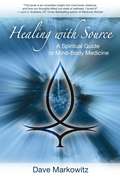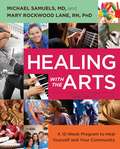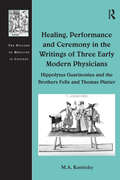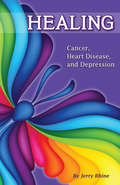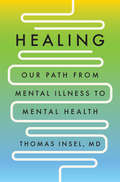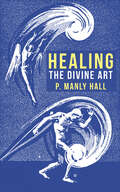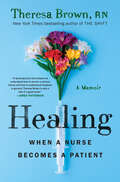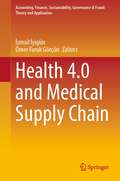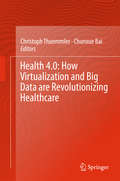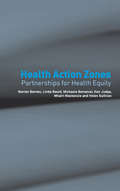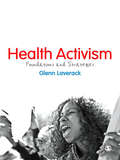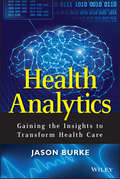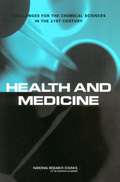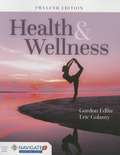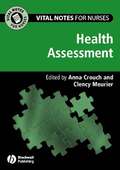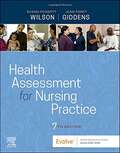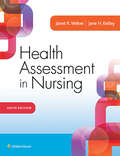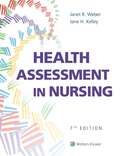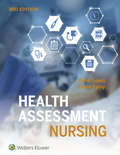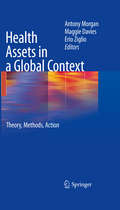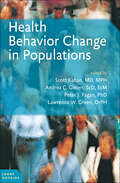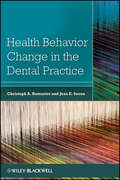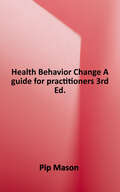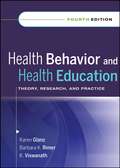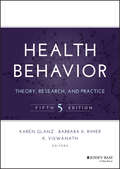- Table View
- List View
Healing with Source
by Dave MarkowitzThe ultimate guide to understanding, preventing, and healing diseases and illnesses, this resource offers simple steps for creating permanent well-being. Emphasizing how repressed emotions, such as anger and grief, can manifest in pain and sickness, this book shows how new, more empowered choices-including forgiveness, openness, and radical acceptance-can prevent problems and heal at the root without the employment of drugs or surgery. With information on how these healing techniques can help and prevent even the most advanced and debilitating illnesses, this essential study raises awareness on the relationship between spiritual growth and health.
Healing with the Arts: A 12-Week Program to Heal Yourself and Your Community
by M.D., Michael Samuels Ph.D., Mary LaneHeal yourself and your community with this proven 12-week program that uses the arts to awaken your innate healing abilities. Acclaimed by hospitals and caretakers from around the world, Healing with the Arts brings a tried and true program out of the medical field and into your home and neighborhood. Improve your physical, mental, emotional, and spiritual health in just 12 weeks. Whether you are ill, suffering from emotional trauma, or looking to unite your community, the arts become the conduit to restore your wellness and thrive in life. Dr. Michael Samuels and Dr. Mary Rockwood Lane created and developed this unique and powerful process to help anyone heal. Through innovative art projects--from the visual arts, movement and dance, writing, and music--along with spiritual practices and guided imagery, readers learn to get in touch with their inner muse and inner healer. Based on years of research and experience in the medical community, Healing with the Arts sets the stage for a more meaningful and healthier existence.
Healing, Performance and Ceremony in the Writings of Three Early Modern Physicians: Hippolytus Guarinonius And The Brothers Felix And Thomas Platter (The History of Medicine in Context)
by M.A. KatritzkyWhile the writings of early modern medical practitioners habitually touch on performance and ceremony, few illuminate them as clearly as the Protestant physicians Felix Platter and Thomas Platter the Younger, who studied in Montpellier and practiced in their birth town of Basle, or the Catholic physician Hippolytus Guarinonius, who was born in Trent, trained in Padua and practiced in Hall near Innsbruck. During his student years and brilliant career as early modern Basle's most distinguished municipal, court and academic physician, Felix Platter built up a wide network of private, religious and aristocratic patients. His published medical treatises and private journal record his professional encounters with them as a healer. They also offer numerous vivid accounts of theatrical events experienced by Platter as a scholar, student and gifted semi-professional musician, and during his Grand Tour and long medical career. Here Felix Platter's accounts, many unavailable in translation, are examined together with relevant extracts from the journals of his younger brother Thomas Platter, and Guarinonius's medical and religious treatises. Thomas Platter is known to Shakespeare scholars as the Swiss Grand Tourist who recorded a 1599 London performance of Julius Caesar, and Guarinonius's descriptions of quack performances represent the earliest substantial written record of commedia dell'arte lazzi, or comic stage business. These three physicians' records of ceremony, festival, theatre, and marketplace diversions are examined in detail, with particular emphasis on the reactions of 'respectable' medical practitioners to healing performers and the performance of healing. Taken as a whole, their writings contribute to our understanding of many aspects of European theatrical culture and its complex interfaces with early modern healthcare: in carnival and other routine manifestations of the Christian festive year, in the extraordinary performance and ceremony of court festivals, and above all in the rarely welcomed intrusions of quacks and other itinerant performers.
Healing: Cancer, Heart Disease, and Depression
by Jerry RhineThe purpose of this book is to provide readers with the power to utilize the mind's ability to create physiological changes in their bodies in combination with western medicine to reverse life-threatening illnesses such as cancer, heart disease, diabetes, AIDS, etc. This book provides numerous transforming images, which enable readers to tap into their mind's subconscious, of positive emotional states including Hope, Self-love, Happiness, and Courage, and thereby reverse immune suppressive states of depression and anxiety. To achieve this, the book enables readers to focus on images of a positive emotional state, recalling vivid uplifting memories using all of their senses, which, when repeated, can result in emotional and physical improvement. The book contains inspiring quotes by the Dalai Lama, Buddha, and William Wordsworth, suggestions for specific action including forgiving someone who has hurt them and feeling a sense of peace, and supporting facts, studies, and science, including gene therapy and quantum physics.
Healing: Our Path from Mental Illness to Mental Health
by Thomas InselA bold, expert, and actionable map for the re-invention of America&’s broken mental health care system.&“Healing is truly one of the best books ever written about mental illness, and I think I&’ve read them all." —Pete Earley, author of CrazyAs director of the National Institute of Mental Health, Dr. Thomas Insel was giving a presentation when the father of a boy with schizophrenia yelled from the back of the room, &“Our house is on fire and you&’re telling me about the chemistry of the paint! What are you doing to put out the fire?&” Dr. Insel knew in his heart that the answer was not nearly enough. The gargantuan American mental health industry was not healing millions who were desperately in need. He left his position atop the mental health research world to investigate all that was broken—and what a better path to mental health might look like. In the United States, we have treatments that work, but our system fails at every stage to deliver care well. Even before COVID, mental illness was claiming a life every eleven minutes by suicide. Quality of care varies widely, and much of the field lacks accountability. We focus on drug therapies for symptom reduction rather than on plans for long-term recovery. Care is often unaffordable and unavailable, particularly for those who need it most and are homeless or incarcerated. Where was the justice for the millions of Americans suffering from mental illness? Who was helping their families? But Dr. Insel also found that we do have approaches that work, both in the U.S. and globally. Mental illnesses are medical problems, but he discovers that the cures for the crisis are not just medical, but social. This path to healing, built upon what he calls the three Ps (people, place, and purpose), is more straightforward than we might imagine. Dr. Insel offers a comprehensive plan for our failing system and for families trying to discern the way forward. The fruit of a lifetime of expertise and a global quest for answers, Healing is a hopeful, actionable account and achievable vision for us all in this time of mental health crisis.
Healing: The Divine Art
by Manly Palmer HallSickness, in ancient times, was due largely to ignorance of the physical laws governing health. In the modern world, sickness is more often the result of ignorance of the laws governing the spiritual, mental, and emotional forces operating in people’s lives. In this now classic exposition of Metaphysical Medicine, Manly Hall argues that although we have largely conquered those external, physical factors, we continue to ignore the internal at great cost to our personal health and well-being. Consisting of both a historical and clinical sections, Hall's Healing: The Divine Art is essential reading for anyone interested in cross-cultural medical practice and alternative therapies.
Healing: When a Nurse Becomes a Patient
by Theresa BrownFrom the New York Times bestselling author of The Shift comes a frank look at navigating the world of healthcare as a cancer nurse becomes a patient and experiences the system from the other side. Despite her training and years of experience as an oncology and hospice nurse, Brown finds it difficult to navigate the medical maze from the other side of the bed. Why is she so often left in the dark about procedures and treatments? Why is she expected to research her own best treatment options? Why is there so much red tape? At times she&’s mad at herself for not speaking up and asking for what she needs but knows that being a &“difficult&” patient could mean she gets worse care. Of the almost four million women in this country living with breast cancer, many have had, like Brown, a treatable form of the disease. Both unnerving and extremely relatable, her experience shows us how our for-profit health care industry &“cures&” us but at the same time leaves so many of us feeling alienated and uncared for. As she did so brilliantly in her New York Times bestseller, The Shift, Brown relays the unforgettable details of her daily life—the needles, the chemo drugs, the rubber gloves, the bureaucratic frustrations—but this time from her new perch as a patient, looking back at some of her own cases and considering what she didn&’t know then about the warping effects of fear and the healing virtues of compassion. &“People failed me when I was a patient and I failed patients when working as a nurse. I see that now,&” she writes.Healing is must-read for all of us who have tried to find healing through our health-care system.
Health 4.0 and Medical Supply Chain (Accounting, Finance, Sustainability, Governance & Fraud: Theory and Application)
by İsmail İyigün Ömer Faruk GörçünThis book examines the new developments in health 4.0 and the medical supply chain. Although supply chain applications in health systems are similar to other sectors, the most critical difference is that any disruption affects public health. There have been changes due to COVID-19 that caused significant disruptions in the supply chain of almost all sectors. The health sector is one of the most important sectors affected by all these extraordinary conditions. Supply chain management is even more critical because the health sector directly impacts the sustainability of human life and the provision of better living conditions. In this book, the use of artificial intelligence in the health and medical supply chain is discussed, taking into account the conditions of the post-pandemic period.
Health 4.0: How Virtualization and Big Data are Revolutionizing Healthcare
by Christoph Thuemmler Chunxue BaiThis book describes how the creation of new digital services--through vertical and horizontal integration of data coming from sensors on top of existing legacy systems--that has already had a major impact on industry is now extending to healthcare. The book describes the fourth industrial revolution (i. e. Health 4. 0), which is based on virtualization and service aggregation. It shows how sensors, embedded systems, and cyber-physical systems are fundamentally changing the way industrial processes work, their business models, and how we consume, while also affecting the health and care domains. Chapters describe the technology behind the shift of point of care to point of need and away from hospitals and institutions; how care will be delivered virtually outside hospitals; that services will be tailored to individuals rather than being designed as statistical averages; that data analytics will be used to help patients to manage their chronic conditions with help of smart devices; and that pharmaceuticals will be interactive to help prevent adverse reactions. The topics presented will have an impact on a variety of healthcare stakeholders in a continuously global and hyper-connected world. #65533; Presents explanations of emerging topics as they relate to e-health, such as Industry 4. 0, Precision Medicine, Mobile Health, 5G, Big Data, and Cyber-physical systems; #65533; Provides overviews of technologies in addition to possible application scenarios and market conditions; #65533; Features comprehensive demographic and statistic coverage of Health 4. 0 presented in a graphical manner.
Health Action Zones: Partnerships for Health Equity
by Marian Barnes Helen Sullivan Linda Bauld Ken Judge Michaela Benzeval Mhairi MackenzieHealth Action Zones (HAZ) were one of the earliest and most prominent area-based initiatives launched by the New Labour government in England soon after it came to power in 1997. Written by members of the team undertaking the national evaluation of HAZ, this book examines the initiative’s development and impact from a variety of perspectives. It outlines important features of the social, policy and evaluative environment within which HAZ were established and discusses enduring themes such as building and developing capacity with diverse and unequal partners within complex policy systems. Multidisciplinary in nature, the book provides in-depth analysis of a key policy initiative, offering guidance on how best to design, implement and evaluate future initiatives intended to deal with fundamental social problems.
Health Activism: Foundations and Strategies
by Glenn LaverackActivism is action on behalf of a cause, action that goes beyond what is conventional or routine and is relative to the actions by others. Health activism is a growing area of interest for many who work to improve health at both national and international levels because it offers a more direct approach to achieve lasting social and political change. This book, for the first time, provides a clear foundation to the theory, evidence-base and strategies that can be harnessed to bring about change to improve the lives and health of others. For anyone working to improve the health of groups and communities, this will be thought-provoking reading. It has particular relevance for postgraduate students and practitioners in public health and health promotion.
Health Analytics: Gaining the Insights to Transform Health Care
by Jason BurkeA hands-on, analytics road map for health industry leaders The industry-wide transformation taking place across the health and life sciences ecosystem is mandating that organizations adopt new decision-making capabilities, based on science and real-world information. Analytics will be a required competency for the modern health enterprise; this book is about how to "cross the chasm." The ultimate analytics guide for the health industry leader, this essential book equips business leaders with little-to-no experience in analytics to understand how to incorporate analytics as a cornerstone of their 21st century competitive business strategy. Paints the picture for a new health enterprise, one focused on the patient Explores the financial components of this new operating model, using analytics to optimize the tradeoffs between cost and value Deals with the rising role of the consumer, using analytics to create a completely new health engagement model with individual recipients of care Looks at how analytics can drive innovations in care practice, patient-experienced medical outcomes, and analytically driven novel therapies optimized for the individual patient Presents a variety of text, tables, and graphics illustrating the various concepts being described Within each section and chapter, Health Analytics assesses the current landscape, proposing a new model/concept, sharing real-world stories of how the old and new world come together, and framing a "how-to" for the reader in terms of growing that particular set of capabilities in their own enterprises.
Health And Medicine
by Medicine Organizing Committee For The Workshop On HealthThe report assesses the current state of chemistry and chemical engineering within the context of drug discovery, disease diagnosis, and disease prevention. Also addressed are chemical and chemical engineering challenges in pharmaceutical synthesis, delivery, and manufacture.
Health And Wellness
by Eric Golanty Gordon EdlinHealth & Wellness, Twelfth Edition covers many facets of personal health, including physical, emotional, mental, social, environmental, and spritual perspectives. Written in a personal and engaging style, the Twelfth Edition encourages students to make the right health choices and gives them the tools and information they need to improve their health habits.
Health Assessment (Vital Notes for Nurses #3)
by Anna T Crouch Clency MeurierHealth assessment is central to effective planning, implementation and evaluation of nursing care. All nurses are accountable for the care they provide and need to be able to accurately determine patient needs in order to plan and deliver evidence-based care. Vital notes for nurses: Health assessment provides students with the knowledge required to consider the many different factors which can influence patient’s health, comfort, well-being and recovery and to confidently assess patient needs. Vital notes for nurses: Health assessment explores concepts of holism, health and illness, factors to consider when assessing patients, communication skills needed for assessment, and all aspects of holistic assessment including physical, psychological, social, cultural and spiritual factors and nutritional needs. * Provides a concise, accessible introduction to health assessment * Includes physical, psychological, social, cultural and spiritual health assessment * Explores essential concepts in assessment and care planning * Within the Vital Notes for Nurses series * Adopts a holistic approach
Health Assessment for Nursing Practice
by Jean Foret Giddens Susan Fickertt WilsonMake the most of your study time and maximize your health assessment skills! Health Assessment for Nursing Practice, 7th Edition focuses on what you need to know, providing easy-to-understand guidelines for an effective physical examination as well as preparation for the Next Generation NCLEX® Examination (NGN). New to this edition is a greater emphasis on normal findings and less on abnormal findings, new LGBTQ+ Considerations boxes, and new NGN Exam-style case studies. Written by noted nursing educators Susan Fickertt Wilson and Jean Foret Giddens, this book has everything you need to conduct and document an accurate assessment, succeed on the NGN, and prepare for clinical practice. Binder-Ready Edition: This loose-leaf copy of the full text is a convenient, accessible, and customizable alternative to the bound book. With this binder-ready edition, students can personalize the text to match their unique needs!
Health Assessment in Nursing
by Janet R. Weber Jane H. KelleyPublisher’s Note: Products purchased from 3rd Party sellers are not guaranteed by the Publisher for quality, authenticity, or access to any online entitlements included with the product. Now in its sixth edition, the innovative, systematic, and easy to understand Health Assessment in Nursing has already helped thousands of RN-seeking students develop the comprehensive knowledge base and expert nursing assessment skills necessary for accurate collection of client data. The authors provide in-depth, accurate information, a compelling Continuing Case Study that covers every step in the assessment process, a focus on diversity and health assessment through the lifespan, a striking photo and illustration program that includes photos of practicing nurses performing assessments, dynamic online video clips and animations, and much more. This book provides students everything needed to master the knowledge and assessment skills needed for a successful nursing career. KEY FEATURES NEW! Focused/Specialized Assessments signaled with icons and introduced with explanatory text help differentiate between skills that are more specialized for specific settings NEW! Verbally Communicating Findings boxes include brief biographical information and the patient’s chief concern followed by a report of “significant positives” and “significant negatives” to help students understand how to better communicate with colleagues Continuing Case Studies with COLDSPA mnemonic Evidence-Based Health Promotion and Disease Prevention boxes Assessment Guides Assessment Tools Safety Tips Clinical Tips Older Adult Considerations Cultural Considerations
Health Assessment in Nursing
by Janet R. Weber Jane H. KelleyPraised for its colorful, visually engaging approach to assessment, Health Assessment in Nursing, 7th Edition makes assessment concepts easy to understand and helps students cultivate the knowledge and skills to confidently perform effective health assessments in a variety of healthcare settings. This updated 7th Edition reflects the latest trends and topical issues in nursing practice and incorporates a suite of powerful learning tools to strengthen students’ critical thinking capabilities and ensure effective data analysis and problem detection for nursing clients.
Health Assessment in Nursing Australia and New Zealand Edition: Australian And New Zealand Edition
by David Foley Peter J. LewisThis practice-oriented, person-centred learning tool will help you acquire the knowledge, skills and competencies you need to perform accurate health assessments in an ever-changing health care environment. The text helps you learn how to think like a health care professional by developing your clinical reasoning skills. It guides you through collecting assessment data before moving on to discussing the health assessment of each patient, explaining the decision-making process used to identify patient problems.
Health Assets in a Global Context
by Maggie Davies Antony Morgan Erio ZiglioAs global health inequities continue to widen, policymakers are redoubling their efforts to address them. Yet the effectiveness and quality of these programs vary considerably, sometimes resulting in the reverse of expected outcomes. While local political issues or cultural conflicts may play a part in these situations, an important new book points to a universal factor: the prevailing deficit model of assessing health needs, which puts disadvantaged communities on the defensive while ignoring their potential strengths. The asset model proposed in Health Assets in a Global Context International Health and Development offers a necessary complement to the problem-focused framework by assessing multiple levels of health-promoting aspects in populations, and promoting joint solutions between communities and outside agencies. The book provides not only rationales and methodologies (e.g., measuring resilience and similar elusive qualities) but also concrete examples of asset-based initiatives in use across the world on the individual and community levels.
Health Behavior Change in Populations
by Peter J. Fagan Scott Kahan, MD, MPH Andrea C. Gielen, ScD, ScM Lawrence W. Green, DrPHFocuses on today’s major public health concerns to teach students the principles of population health behavior and behavior change.The single greatest way to improve health and quality of life is not by developing new medical approaches, but by addressing harmful personal behaviors. These behaviors—which include tobacco, alcohol, and drug use, diet, and physical activity—play a significant role in the risk for and development, treatment, and management of the most common causes of disease, disability, and death in the modern world. Health Behavior Change in Populations is designed to teach students and practitioners strategic principles for creating positive behavioral change on a population level. With an emphasis on the application of theory and research to practice, this textbook presents current and future public health professionals with a range of methods geared towards helping people make healthy choices, from informing the individual to modifying the surroundings and circumstances that drive decision-making. Written and edited by experts in the health professions, the book is arranged into three sections: State of the Field, State of the Science, and Cross-Cutting Issues. The chapters within these sections include learning objectives with boldfaced keywords and a glossary of terms. Each chapter addresses• The magnitude of the public health burden• Key determinants and conceptual framework for behaviors and behavior change, including individual, familial, interpersonal, community, sociocultural, structural, and political perspectives• Current evidence-based interventions and best practices• Roles for key stakeholders, including health plans, employers/workplace, health departments/agencies, sectors such as recreational and agricultural, policymakers, community groups/advocates, clinics/clinicians, researchers, and funding institutions • Considerations for implementation, evaluation, and translation
Health Behavior Change in the Dental Practice
by Christoph A. Ramseier Jean E. SuvanHealth Behavior Change in the Dental Practice presents an overview of health behavior change, focusing on the spirit of motivational interviewing. Targeting the clinical application of the principles, the book applies lessons learned from the field of general and behavioral medicine to the dental practice. By presenting a series of clinical examples and accompanying dialogue, the book guides the reader in using motivational interviewing techniques as tools for oral hygiene education, tobacco use cessation, and dietary counseling. Health Behavior Change in the Dental Practice supports the trend towards risk management in oral health care, offering practical guidance to promote health behavior change in patients.
Health Behavior Change: A Guide for Practitioners
by Pip MasonBased upon a tried and tested framework of intervention, Health Behavior Change, third edition, brings together the field of communication, the study of motivation and how people change, and insights derived from listening to and observing patients over many years, to provide a helpful source of advice on how to encourage individuals to embrace behaviour change and then maintain it. <p><p> This popular paperback is written in a friendly and accessible writing style, and contains an abundance of ‘real-life’ clinical cases, sample interviews, and the latest evidence-base regarding best practice. The book also contains information on learning the necessary techniques, overcoming personal barriers to success, and how to use the techniques in a wide variety of settings. Learning aids include ‘Useful Questions’ boxes, to help learners structure consultations, ‘Key Points’ boxes, to summarise the crucial ‘take home’ message, and ‘What to Avoid’ boxes, which give the benefit of extensive experience. <p><p> The new edition now comes with an EVOLVE© website which contains a helpful video demonstration of a successful interview, an explanatory transcript of which is given within the book, and downloadable Patient Worksheets. <p><p> Suitable for a wide-ranging readership ranging from primary care physicians and nurses to physiotherapists and sports therapists, this book will be perfect for usein the primary care setting, inpatient or outpatient departments, community health projects, the A&E department, leisure facilities and occupational health clinics.
Health Behavior and Health Education
by K. Viswanath Karen Glanz Barbara RimerResources for teaching and learning are posted at tinyurl.com/Glanz4e and www.med.upenn.edu/hbhe4.This fourth edition of the classic book, Health Behavior and Health Education: Theory, Research, and Practice provides a comprehensive, highly accessible, and in-depth analysis of health behavior theories that are most relevant to health education. This essential resource includes the most current information on theory, research, and practice at individual, interpersonal, and community and group levels. This edition includes substantial new content on current and emerging theories of health communication, e-health, culturally diverse communities, health promotion, the impact of stress, the importance of networks and community, social marketing, and evaluation.
Health Behavior: Theory, Research, and Practice (Jossey-Bass Public Health)
by Barbara K. Rimer K. Viswanath Karen GlanzThe essential health behavior text, updated with the latest theories, research, and issues Health Behavior: Theory, Research and Practice provides a thorough introduction to understanding and changing health behavior, core tenets of the public health role. Covering theory, applications, and research, this comprehensive book has become the gold standard of health behavior texts. This new fifth edition has been updated to reflect the most recent changes in the public health field with a focus on health behavior, including coverage of the intersection of health and community, culture, and communication, with detailed explanations of both established and emerging theories. Offering perspective applicable at the individual, interpersonal, group, and community levels, this essential guide provides the most complete coverage of the field to give public health students and practitioners an authoritative reference for both the theoretical and practical aspects of health behavior. A deep understanding of human behaviors is essential for effective public health and health care management. This guide provides the most complete, up-to-date information in the field, to give you a real-world understanding and the background knowledge to apply it successfully. Learn how e-health and social media factor into health communication Explore the link between culture and health, and the importance of community Get up to date on emerging theories of health behavior and their applications Examine the push toward evidence-based interventions, and global applications Written and edited by the leading health and social behavior theorists and researchers, Health Behavior: Theory, Research and Practice provides the information and real-world perspective that builds a solid understanding of how to analyze and improve health behaviors and health.
